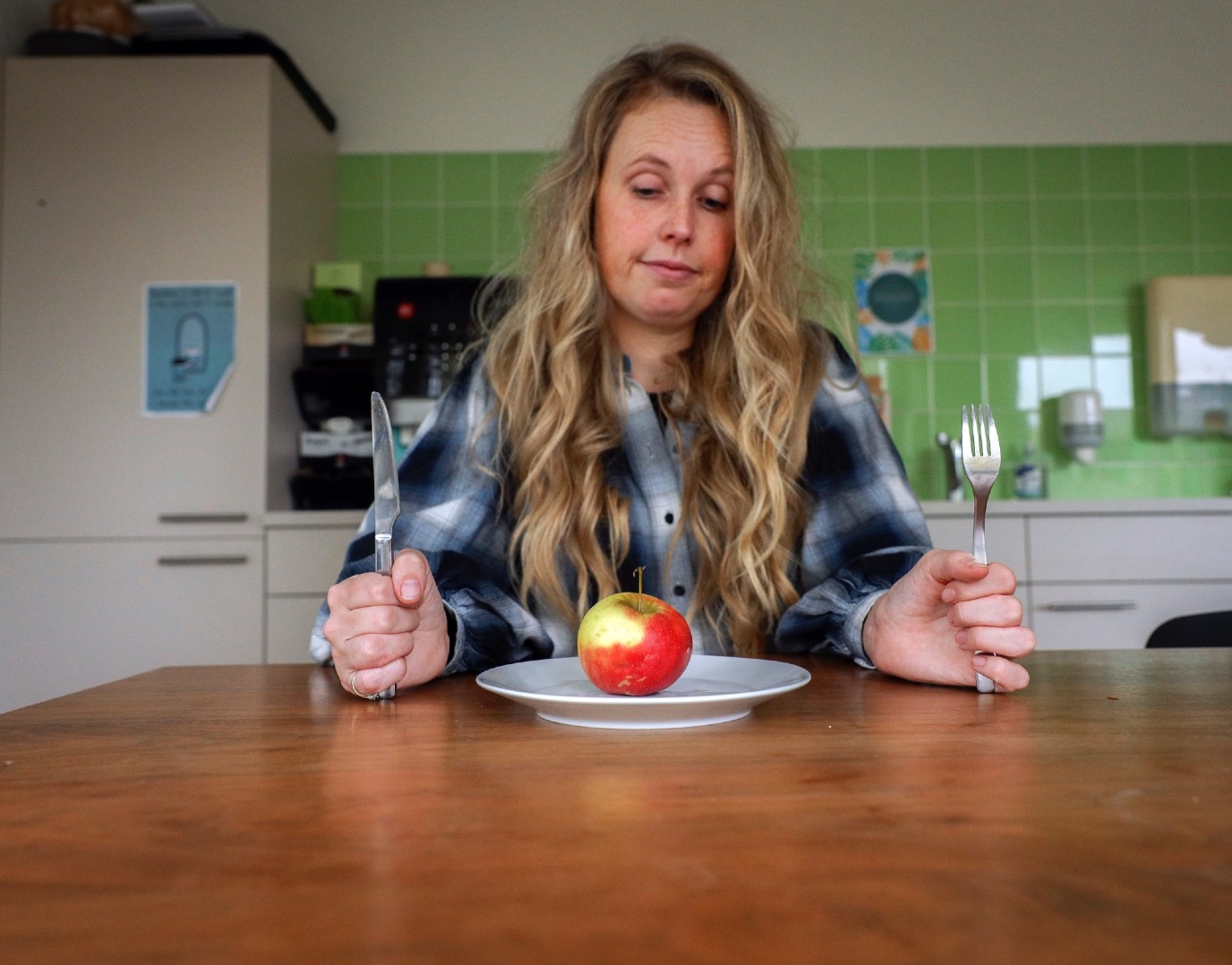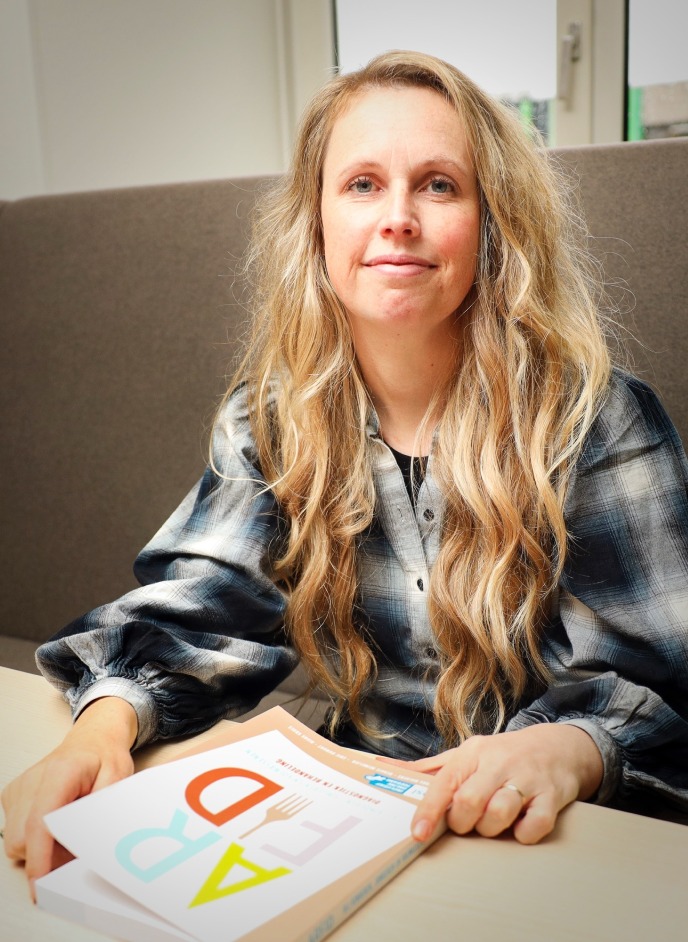The fear of eating

When you think of an eating disorder, your mind immediately goes to extreme weight loss or, contrarily, obesity. Eating disorders can take many shapes and forms, however, often manifesting in various ways and having various causes. Renate Neimeijer conducts research into eating disorders among children and young adults. She is a researcher and lecturer at the UG and a clinical psychologist at Accare, where she treats young people who suffer from anorexia and other eating disorders. Her current research focuses on ARFID: avoidant/restrictive food intake disorder.
Text: Jaap Ploeger, Corporate Communication / Photos: Henk Veenstra
Starvation
Among other research topics she pursued at the UG, Neimeijer investigated dysfunctional information processing in eating disorders. She did her PhD research on disturbed information processing in anorexia. She says: ‘I was conducting research into the phenomenon that young adults with anorexia are able to persevere in starving themselves for so long. I wondered how that is possible. It’s of course an extreme form of dieting to attain a certain body ideal. What we see with an average diet is that people quit after a couple of weeks or months, either because they can’t persevere or because they have achieved their goal. It apparently doesn’t work that way for girls with anorexia nervosa, and I wanted to understand why that is.’

Subconscious compulsive avoidance
Her research showed that these young women—95% of patients with anorexia are women—responded to food or images of food on a subconscious level. ‘When you or I are hungry and we are walking down a shopping street, our attention is drawn to restaurants, cafés, and images of food. We noticed that these girls experienced images of food as threatening. In addition to the conscious desire to lose weight, this subconscious response could help to persevere with the dieting behaviour.’ They also struggle more and more to make good choices due to them being underweight and related symptoms. This snowball effect also ensures that they are unable to stop their extreme behaviour. The majority of patients respond well to cognitive behavioural therapy.
ARFID
Eating disorders have various causes. Sometimes, it is not possible to point out a clear cause or reason. However, Neimeijer sometimes also sees unsafe social environments in which bullying occurs, resulting in body dissatisfaction, trauma, or other negative associations with food. Her current research focuses on a relatively new eating disorder: ARFID, which stands for avoidant/restrictive food intake disorder. She explains: ‘With ARFID, a classification was created that gives practitioners a better grip on severe eating disorders that can develop in various ways. For example, a child can have sensory sensitivities, making it hard for them to chew or swallow certain types of food that have a particular taste or structure. A child can be anxious because they once nearly choked on a certain product. It’s also possible that the child struggles with sensing if they are hungry, which then often gives rise to a lot of hassle around meals at home. Eating will then have an increasingly negative association.’

Desperate parents
We all remember the Brussels sprouts from our own childhood that did not get eaten, but with this group, it goes a lot further than that, which may jeopardize the child’s health. If a child does not eat, it has major consequences for a family and puts enormous pressure on the parents. ‘I know examples of parents who are truly desperate and just give their child a chocolate sprinkles sandwich, so that they don’t go to bed hungry. These cases end up at Accare for an intake interview,’ she says. Neimeijer wants to use her research to better understand the various reasons for developing ARFID and to know how GPs and healthcare providers can recognize it.
Treatments
In the treatment of ARFID and other eating disorders, it is important to identify the underlying reason for the behaviour and to redirect it to healthy behaviour. This behavioural adjustment is particularly done through cognitive behavioural therapy but, according to Neimeijer, it is also important that the whole family gets involved when it concerns a fear of eating. ‘If feeding your child turns into a battle every single night, we want to treat the child but we also want to involve the parents and any siblings. It’s important to break down certain ingrained patterns. These families should experience mealtimes as a nice moment together again and not as a battle.’
Incorrect thoughts
Children who need to vomit from eating certain foods or who feel anxious may benefit from exposure therapy. By taking small bites, discovering the structure of a food, and focusing on that, therapists try to take away their anxiety. ‘We want to teach children that the thoughts they have about food are untrue,’ says Neimeijer. In very exceptional cases, it is necessary to administer food to a child via a tube because otherwise, they will develop severe deficits and growth problems. This nasogastric feeding is of course very invasive and should preferably be avoided. She emphasizes that for the majority of patients either the child or the parent seeks help in time and that the disorder is very treatable.
10 years
Together with her fellow researchers from Maastricht, Neimeijer has just published a book containing treatment strategies for ARFID. This handbook serves as a tool for practitioners in dealing with the diagnostics and treatment of ARFID. ‘The diagnosis has been around for more than 10 years now and we know more and more about it, improving its recognition and treatment. I’m hoping my current research will also contribute to that,’ Neimeijer says in conclusion.
More information
| Last modified: | 26 November 2024 12.11 p.m. |
More news
-
17 March 2025
Liekuut | The high price of conflicts
According to Carsten de Dreu, Professor of Foundations of Cooperation and Social Organization at the University of Groningen, a lot can be learned from conflicts.
-
10 March 2025
Science for Society | Memory Lab for higher marks
Learning facts at school is something hardly anyone likes. The day before a test, pupils cram as many words or names as possible into their heads, only to hopefully remember them the next morning and then forget them again after the test.
-
05 March 2025
Women in Science
The UG celebrates International Women’s Day with a special photo series: Women in Science.
